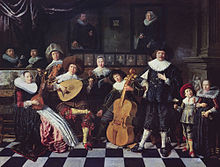art.wikisort.org - Artist
Jan Miense Molenaer (1610 – buried 19 September 1668),[1] was a Dutch Golden Age genre painter whose style was a precursor to Jan Steen's work during Dutch Golden Age painting.[2] He shared a studio with his wife, Judith Leyster, also a genre painter, as well as a portraitist and painter of still-life. Both Molenaer and Leyster may have been pupils of Frans Hals.


Biography
Molenaer was born and died in Haarlem. He achieved a style close to Hals' early on in his career, but later developed a style like that of Dutch genre painter, Adriaen van Ostade.[3] His genre works often depicted players of music, such as his The Music Makers (Museum of Fine Arts, Budapest), The Duet (Seattle Art Museum), or Family Making Music (Frans Hals Museum). He also depicted Taverns and the activities of card games or games of the times such as La main chaude, or in Dutch, Handjeklap, which literally means clapping hands. Molenaer also cleverly depicted biblical stories in his own time and surroundings, such as representing a scene from Peter's Gospel set in a Dutch Tavern in The Denying of Peter (Museum of Fine Arts, Budapest).[4][5]
Selected works

- 1629 – The Dentist, Oil on panel, (North Carolina Museum of Art, Raleigh)[6]
- 1629 – Two Boys and a Girl Making Music, Oil on canvas, (National Gallery, London)[7]
- 1630 – A Quack and His Assistant, Oil on canvas, (Private Collection)[3]
- 1630 – The Duet, Oil on canvas, (Seattle Art Museum, Seattle)[8]
- 1630/32 – A Young Man playing a Theorbo and a Young Woman playing a Cittern, Oil on canvas, (National Gallery, London)[9]
- 1631 – Painter in His Studio, Painting a Musical Company, Oil on canvas, (Staatliche Museen, Berlin)[3]
- 1633 – Allegory of Vanity, Oil on canvas, (Toledo Museum of Art, Toledo)[3]
- 1633 – Allegory of Marital Fidelity, Oil on canvas, (Virginia Museum of Fine Arts, Richmond)[10]
- 1633/35 – Battle Between Carnival and Lent, Oil on wood, (Indianapolis Museum of Art, Indianapolis)[11]
- 1635 – Card Players, Oil on panel, (Currier Museum of Art, Manchester)[12]
- 1635 – Young Smoker, Oil on panel, (Accademia Carrara, Bergamo)[13]
- 1635 – Family Making Music, Oil on panel, (Frans Hals Museum, Haarlem)[14]
- 1636 – The Denying of Peter, Oil on canvas, (Museum of Fine Arts, Budapest)[3]
- 1640s – Woman Holding a Jug, Oil on panel, (Museum of Fine Arts, Boston)[15]
References
- "Home Jan Miense Molenaer". Rkd.nl. Retrieved 2014-06-25.
- "Grove Dictionary of Art". Artnet.com. 2014-06-12. Retrieved 2014-06-25.
- "Web Gallery of Art, image collection, virtual museum, searchable database of European fine arts (1000–1900)". Wga.hu. Retrieved 2014-06-25.
- "Kren and Marx Comments on The Denying of Peter in the Web Gallery of Art, www.wga.hu". Wga.hu. Retrieved 2014-06-25.
- Dennis P. Weller, North Carolina Museum of Art; Cynthia Von Bogendorf Rupprath; Mariët Westermann (2002). Jan Miense Molenaer: Painter of the Dutch Golden Age. Hudson Hills. ISBN 9780882599885. Retrieved 27 June 2013.
- "The Dentist". North Carolina Museum of Art. Archived from the original on 2019-02-24. Retrieved 2019-05-04.
- "Jan Miense Molenaer | Two Boys and a Girl making Music | NG5416 | The National Gallery, London". Nationalgallery.org.uk. Archived from the original on 2009-05-07. Retrieved 2014-06-25.
- "The Duet, ca. 1629". Archived from the original on September 27, 2007. Retrieved July 23, 2007.
- "Jan Miense Molenaer | A Young Man and Woman making Music | NG1293 | The National Gallery, London". Nationalgallery.org.uk. Archived from the original on 2009-05-28. Retrieved 2014-06-25.
- "Virginia Museum of Fine Arts | Richmond, Virginia". Vmfa.state.va.us. Archived from the original on 2009-01-15. Retrieved 2014-06-25.
- "Archived copy". www.ima-art.org. Archived from the original on 29 September 2007. Retrieved 17 January 2022.
{{cite web}}: CS1 maint: archived copy as title (link) - "EmbARK Web Kiosk". collections.currier.org.
- "Giovane fumatore Molenaer Jan Miense 58MR00063 – Accademia Carrara di Bergamo Pinacoteca". Accademia Carrara di Bergamo Pinacoteca.
- "Molenaer, Jan Miense, Haarlem 1610/11 - Haarlem 1668, Family Making Music, c. 1635". Archived from the original on September 27, 2007. Retrieved July 23, 2007.
- "Collections | Museum of Fine Arts, Boston". Mfa.org. Archived from the original on 2007-10-27. Retrieved 2014-06-25.
External links
![]() Media related to Jan Miense Molenaer at Wikimedia Commons
Media related to Jan Miense Molenaer at Wikimedia Commons
- wga.hu, List of painters in the Web Gallery of Art
- Political Iconography in a Painting by Jan Miense Molenaer
- Works and literature on Jan Miense Molenaer
На других языках
[de] Jan Miense Molenaer
Jan Miense Molenaer (* um 1610 in Haarlem; † 15. September 1668 ebenda) war ein niederländischer Maler und Radierer.- [en] Jan Miense Molenaer
[es] Jan Miense Molenaer
Jan Miense Molenaer (Haarlem, c. 1610-Haarlem, enterrado el 19 de septiembre 1668),[2] fue un pintor y grabador holandés cuyo estilo fue precursor del de Jan Steen durante la llamada Edad de oro de la pintura holandesa.[3][fr] Jan Miense Molenaer
Jan Miense Molenaer (vers 1610 à Haarlem, Pays-Bas – enterré 19 septembre 1668 à Haarlem) est un peintre baroque néerlandais (Provinces-Unies) du siècle d’or, connu surtout pour ses scènes de genre. Il fut l’époux de la femme peintre Judith Leyster.[it] Jan Miense Molenaer
Jan Miense Molenaer (talvolta scritto Molenaar[1]; Haarlem, 1610 ca. – Haarlem, 15 settembre 1668) è stato un pittore olandese, tra gli esponenti del periodo noto come Secolo d'Oro[2].[ru] Моленар, Ян Минсе
Ян Минсе Моленар (нидерл. Jan Miense Molenaer, 1610, Харлем — 15 сентября 1668, там же) — голландский живописец и график эпохи барокко.Другой контент может иметь иную лицензию. Перед использованием материалов сайта WikiSort.org внимательно изучите правила лицензирования конкретных элементов наполнения сайта.
WikiSort.org - проект по пересортировке и дополнению контента Википедии